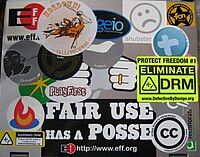Pressure-sensitive adhesive

Okay kiddo, imagine you're playing with some stickers. You know how sometimes when you take them off the paper, they stick to your fingers and you have a hard time getting them off? That's because they have something called pressure-sensitive adhesive on the back.
Pressure-sensitive adhesive is kind of like a super sticky glue that can stick to things with just a little bit of pressure. That means you don't need any special tools or chemicals to make it stick, you can just press it onto something and it will stay there.
But how does it work? Well, pressure-sensitive adhesive is made up of lots of tiny particles called polymers. These polymers are attracted to each other, which makes them stick together.
When you press the adhesive onto something, those polymers get even more attracted to each other, and they create a strong bond. That's why the sticker stays on your finger so well - the pressure from your finger is making the polymers in the adhesive bond together tightly.
And here's something cool: pressure-sensitive adhesive doesn't actually stick to everything! It's designed to only stick to certain surfaces, like paper or plastic. That's because those surfaces have a certain amount of "surface energy" that helps the adhesive bond to them. Other surfaces, like glass or metal, might not have the right kind of surface energy, so the adhesive won't stick as well (or at all).
So, in summary, pressure-sensitive adhesive is a really sticky glue that can stick to things just by applying a little bit of pressure. It's made up of tiny particles called polymers that bond together when you press them together. And it only sticks to certain surfaces, based on something called "surface energy." Pretty neat, huh?
Pressure-sensitive adhesive is kind of like a super sticky glue that can stick to things with just a little bit of pressure. That means you don't need any special tools or chemicals to make it stick, you can just press it onto something and it will stay there.
But how does it work? Well, pressure-sensitive adhesive is made up of lots of tiny particles called polymers. These polymers are attracted to each other, which makes them stick together.
When you press the adhesive onto something, those polymers get even more attracted to each other, and they create a strong bond. That's why the sticker stays on your finger so well - the pressure from your finger is making the polymers in the adhesive bond together tightly.
And here's something cool: pressure-sensitive adhesive doesn't actually stick to everything! It's designed to only stick to certain surfaces, like paper or plastic. That's because those surfaces have a certain amount of "surface energy" that helps the adhesive bond to them. Other surfaces, like glass or metal, might not have the right kind of surface energy, so the adhesive won't stick as well (or at all).
So, in summary, pressure-sensitive adhesive is a really sticky glue that can stick to things just by applying a little bit of pressure. It's made up of tiny particles called polymers that bond together when you press them together. And it only sticks to certain surfaces, based on something called "surface energy." Pretty neat, huh?
Related topics others have asked about:
